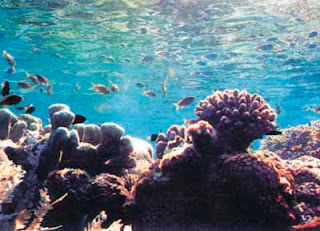Scuba diving attracts many visitors to the island.
Bunaken is located at the north of the island of Sulawesi, Indonesia. It belongs administratively to the municipality of Manado.
The Bunaken National Marine Park was formally established in 1991 and is among the first of Indonesia's growing system of marine parks.
The park covers a total surface area of 890.65 km², 97% of which is overlain by sparkling clear, warm tropical water.
The remaining 3% of the park is terrestrial, including the five islands of Bunaken, Manado Tua, Mantehage, Nain and Siladen.
Although each of these islands has a special character, it is the aquatic ecosystem that attracts most naturalists.
The waters of Bunaken National Marine Park are extremely deep (1566 m in Manado Bay), clear (up to 35-40 m visibility), refreshing in temperature (27 to 29 °C) Pick any of group of interest - corals, fish, echinoderms or sponges - and the number of families, genera or species is bound to be astonishingly high.
For example, 7 of the 8 species of giant clams that occur in the world, occur in Bunaken.
The park has around 70 genera of corals; compare this to a mere 10 in Hawaii.

Although the exact number of fish species is unknown, it may be slightly higher than in the Philippines, where 2,500 species, or nearly 70% of all fish species known to the Indo-western Pacific, are found.

Oceanic currents may explain, in part, why Bunaken National Marine Park is such a treasure trove of biodiversity.
Northeasternly currents generally sweep through the park but abundant counter currents and gyros related to lunar cycles are believed to be a trap for free swimming larvae.
This is particularly true on the south side of the crescent-shaped Bunaken Island, lying in the heart of the park.

A snorkler or diver in the vicinity of Lekuan or Fukui may spot over 33 species of butterfly fish and numerous types of groupers, damsels, wrasses and gobies.
The gobies, smallish fish with bulging eyes and modified fins that allow them to attach to hard surfaces, are the most diverse but least known group of fish in the park.
Biologists believe that the abundance of hard corals is crucial in maintaining the high levels of diversity in the park.
Hard corals are the architects of the reefs, without them, numerous marine organisms would be homeless and hungry.
Many species of fish are closely associated with particular types of corals (folious, branching, massives, etc.) for shelter and egg-laying.
Others, like the enormous Bumphead Parrotfish, Balbometopon muricatum, are "coralivores" and depend on hard corals for their sustenance.
Bony mouth parts fused into an impressive "beak" allow these gregarious fish to crunch corals like roasted peanuts.
Some 20,000 people live on the natural resources of Bunaken National Marine Park.
Although there are inevitable conflicts between resource protection and use by people, the Indonesian government is taking a fairly unusual and pragmatic approach to park management.
The idea is to promote wise resource use while preventing overexploitation.
Local communities, government officials, dive resort operators, local nature groups, tourists and scientists have played an active role in developing exclusive zones for diving, wood collection, fishing and other forms of utilization.
Bunaken Marine Park has become an important example of how Sulawesi, and the rest of Indonesia, can work to protect its natural resources.
All visitors to the Bunaken National Park (divers and non-divers) are required to pay an entrance fee, in accordance with North Sulawesi Provincial Government Provincial Law Number 9/2002.
The entrance fee for foreign visitors is Rp 50,000 per daily ticket (approximately US$6), or Rp 150,000 (approximately US$17) for a waterproof plastic entrance tag valid for the full calendar year.
Entrance tags and tickets can be purchased direct from all NSWA members, or from ticket counters on Bunaken Island and on Siladen Island.
They must be carried at all times that guests' are within the park boundaries, and tags can easily be affixed to guests' diving or snorkeling gear or on backpacks.
Enforcement of the entrance fee system is conducted via spot checks by park rangers on land and at sea.
The entrance fee system has been adapted from the well-known Bonaire Marine Park system, and the proceeds from the sales of the entrance tags are managed by the Bunaken National Park Management Advisory Board (BNPMAB), a multi-stakeholder board that NSWA is a member of.
The system has been very successful in raising over $250,000 for conservation programs in the Bunaken Marine Park since its inception in 2001.
On the island you have the choice amongst a number of homestays, with rates starting at around Rp. 80 000 per day and person incl. fullboard.
If you only go for the cheapest option don't complain afterwards if the water in your mandi (bathroom) doesn't get filled up regularly, or food isn't quite as nice as you had hoped for.
Life in North Sulawesi in general isn't as cheap as in other regions of Indonesia, and most things on Bunaken have to be brought in from Manado.
Depending on the season even fish can be pretty expensive.
Better think twice before you try to bargain down prices which are already cheap; for the locals it could mean the difference between being able to eat 3 or only 2 meals a day, or buying school books for the children or not.
Some of the dive operations on Bunaken are offering more upmarket accommodation, even hot showers (Living Colours, Cha Cha Nature Resort).
Some guesthouses ("homestays") on Bunaken:Pangalisang Beach: Lorenso's HomestayLiang Beach: Panorama, Nelson's, Papa Boa
There are a lot more...
No comments:
Post a Comment